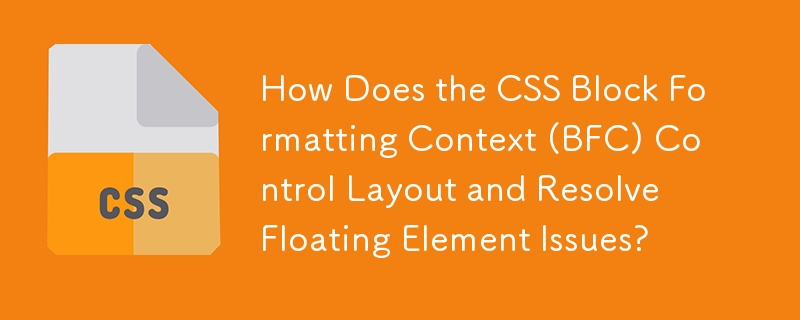 Web Front-end
Web Front-end
 CSS Tutorial
CSS Tutorial
 How Does the CSS Block Formatting Context (BFC) Control Layout and Resolve Floating Element Issues?
How Does the CSS Block Formatting Context (BFC) Control Layout and Resolve Floating Element Issues?
How Does the CSS Block Formatting Context (BFC) Control Layout and Resolve Floating Element Issues?

How does the CSS Block Formatting Context (BFC) work?
In a BFC, elements are placed vertically, beginning from the top, disregarding floating elements unless they create a new BFC. A new BFC is established when an element has:
- Overflow: hidden or scroll
- Float: left or right
- Inline-block display
- Grid or flex display
- Position: absolute or fixed
When a new BFC is established, it isolates its contents from the surrounding environment, preventing floating elements outside the context from affecting the layout of elements within. This is useful for controlling the flow of content, such as in multi-column layouts.
How are boxes laid out in the normal flow?
In the normal flow, boxes are positioned vertically according to their declaration order, with block boxes (like divs) taking up the full width of their parent container, and inline boxes (like spans) taking up only the space they need.
When floating elements are present outside a BFC:
If an element is floated outside of a BFC, it moves to the left or right and pushes the following elements to the opposite side. This is why floated elements "float over" other content, even if they appear later in the HTML.
When floating elements are present inside a new BFC:
When a new BFC is established, floated elements within that context are contained and do not affect elements outside it. This means they can overlap each other or their parent container without disturbing the layout of other content.
Why does establishing a new BFC work?
By isolating the content within a new BFC, floating elements are treated as if they don't exist when determining the layout of the remaining content. This prevents floated elements from clearing floats that appear earlier in the source code, creating a controlled layout.
How BFCs can be used to achieve specific layouts:
By understanding the behavior of BFCs, you can create complex layouts with ease. For example, you can use BFCs to:
- Create multi-column layouts
- Ensure a sidebar's height matches the main content's height
- Prevent adjacent floating elements from overlapping
The above is the detailed content of How Does the CSS Block Formatting Context (BFC) Control Layout and Resolve Floating Element Issues?. For more information, please follow other related articles on the PHP Chinese website!

Hot AI Tools

Undresser.AI Undress
AI-powered app for creating realistic nude photos

AI Clothes Remover
Online AI tool for removing clothes from photos.

Undress AI Tool
Undress images for free

Clothoff.io
AI clothes remover

AI Hentai Generator
Generate AI Hentai for free.

Hot Article

Hot Tools

Notepad++7.3.1
Easy-to-use and free code editor

SublimeText3 Chinese version
Chinese version, very easy to use

Zend Studio 13.0.1
Powerful PHP integrated development environment

Dreamweaver CS6
Visual web development tools

SublimeText3 Mac version
God-level code editing software (SublimeText3)

Hot Topics
 1371
1371
 52
52
 Adding Box Shadows to WordPress Blocks and Elements
Mar 09, 2025 pm 12:53 PM
Adding Box Shadows to WordPress Blocks and Elements
Mar 09, 2025 pm 12:53 PM
The CSS box-shadow and outline properties gained theme.json support in WordPress 6.1. Let's look at a few examples of how it works in real themes, and what options we have to apply these styles to WordPress blocks and elements.
 Working With GraphQL Caching
Mar 19, 2025 am 09:36 AM
Working With GraphQL Caching
Mar 19, 2025 am 09:36 AM
If you’ve recently started working with GraphQL, or reviewed its pros and cons, you’ve no doubt heard things like “GraphQL doesn’t support caching” or
 Making Your First Custom Svelte Transition
Mar 15, 2025 am 11:08 AM
Making Your First Custom Svelte Transition
Mar 15, 2025 am 11:08 AM
The Svelte transition API provides a way to animate components when they enter or leave the document, including custom Svelte transitions.
 Classy and Cool Custom CSS Scrollbars: A Showcase
Mar 10, 2025 am 11:37 AM
Classy and Cool Custom CSS Scrollbars: A Showcase
Mar 10, 2025 am 11:37 AM
In this article we will be diving into the world of scrollbars. I know, it doesn’t sound too glamorous, but trust me, a well-designed page goes hand-in-hand
 Show, Don't Tell
Mar 16, 2025 am 11:49 AM
Show, Don't Tell
Mar 16, 2025 am 11:49 AM
How much time do you spend designing the content presentation for your websites? When you write a new blog post or create a new page, are you thinking about
 Building an Ethereum app using Redwood.js and Fauna
Mar 28, 2025 am 09:18 AM
Building an Ethereum app using Redwood.js and Fauna
Mar 28, 2025 am 09:18 AM
With the recent climb of Bitcoin’s price over 20k $USD, and to it recently breaking 30k, I thought it’s worth taking a deep dive back into creating Ethereum
 What the Heck Are npm Commands?
Mar 15, 2025 am 11:36 AM
What the Heck Are npm Commands?
Mar 15, 2025 am 11:36 AM
npm commands run various tasks for you, either as a one-off or a continuously running process for things like starting a server or compiling code.
 Let's use (X, X, X, X) for talking about specificity
Mar 24, 2025 am 10:37 AM
Let's use (X, X, X, X) for talking about specificity
Mar 24, 2025 am 10:37 AM
I was just chatting with Eric Meyer the other day and I remembered an Eric Meyer story from my formative years. I wrote a blog post about CSS specificity, and



